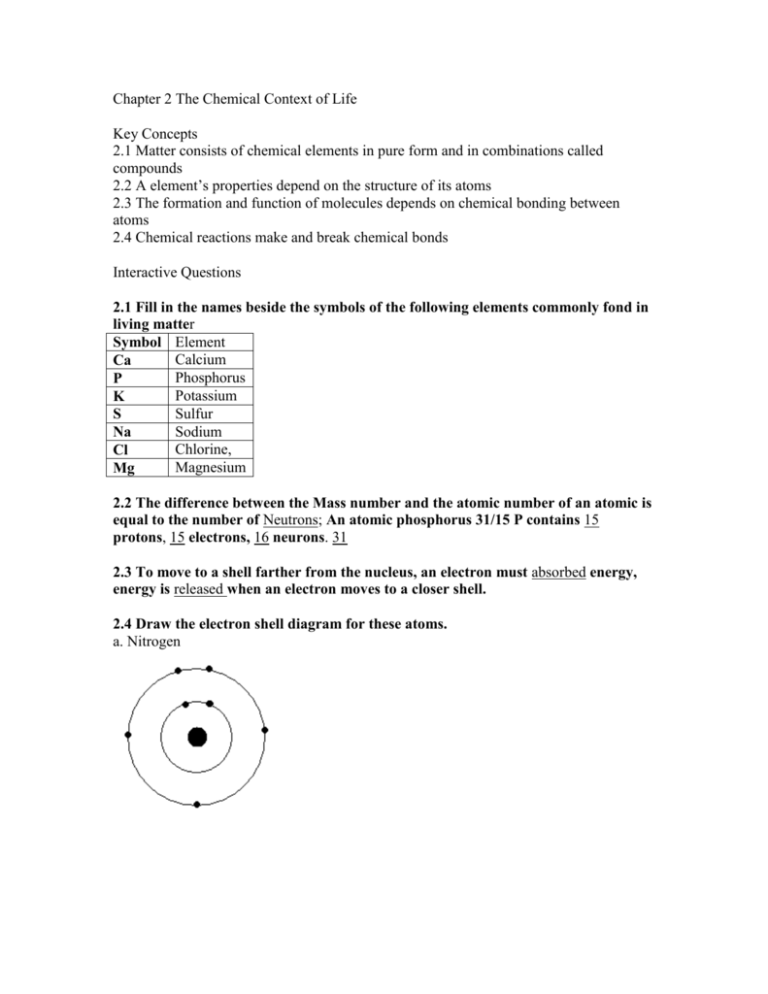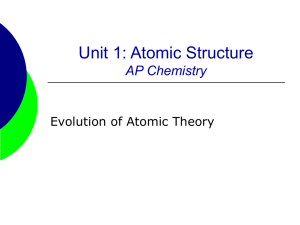Chapter 2 The Chemical Context of Life
advertisement

Chapter 2 The Chemical Context of Life Key Concepts 2.1 Matter consists of chemical elements in pure form and in combinations called compounds 2.2 A element’s properties depend on the structure of its atoms 2.3 The formation and function of molecules depends on chemical bonding between atoms 2.4 Chemical reactions make and break chemical bonds Interactive Questions 2.1 Fill in the names beside the symbols of the following elements commonly fond in living matter Symbol Element Calcium Ca Phosphorus P Potassium K Sulfur S Sodium Na Chlorine, Cl Magnesium Mg 2.2 The difference between the Mass number and the atomic number of an atomic is equal to the number of Neutrons; An atomic phosphorus 31/15 P contains 15 protons, 15 electrons, 16 neurons. 31 2.3 To move to a shell farther from the nucleus, an electron must absorbed energy, energy is released when an electron moves to a closer shell. 2.4 Draw the electron shell diagram for these atoms. a. Nitrogen b. Oxygen c. Magnesium d. Carbon 2.5 Look again at the electron shell diagram you drew for carbon in Interactive Question 2.4. Did you show the outer shell electrons unpaired? Why? Although each orbital can hold a pair of electrons, each electron fills a separate orbital until no empty orbital remain 2.6 Fill in the blanks in th flowing concept map t help you review the atomic structure of atoms. a. Protons b. atomic number c. element d. neutrons e. mass number or atomic ass f. isotopes g. electrons h. electron shell or energy levels e. valence shell 2.7 What are the valances of the four most common elements of living matter? a. 1 b. 2 c. 3 d. 4 2.8 Explain whether the following molecules contain nonpolar or polar covalent bonds a. Non polar; even through N has a high electronegativity, the three pairs of electrons are shared equally between the two N atoms because each atom has an equally strong attraction for the elctionrs. b. Polar; N is more electronegative than H and pulls the shared electrons in each covalent bond clower to itself. c. nonpolar; C and H have similar electronegativities and equally share electrons between them. d. The C= O bond is polar because O is more electronegative than C; the C-h bonds are relatively nonpolar. 2.9 Calcium and chlorine can combine to form the calcium chloride. Based on the number of electrons in their valence shells and their bonding capacities, what could the molecular formula for this salt be? What atom becomes the cation? a. CaCl2 b. Ca^2+ is the cation 2.10 Sketch a water molecule showing oxygen’s electron shells and the covalently shared electrons Indicates the areas with slight negative and positive charges that enable a molecule to form hydrogen bonds with other polar molecules H H 2.11 Look at your diagram of a water molecule in Interactive Question 2.10. Why should its shape be roughly like a V? Water’s two covalent bonds with H are spread apart at a 14.5 angle due to the hybridization of the s and 3 p orbitals. 2.12 Fill in the missing coefficients for respiration the conversion of glucose and oxygen t carbon dioxide and water, so that all atoms are conserved in the chemical reactions. C6H12O6 + 6 O2 6 CO2 + 6 H2O Structure of Knowledge 1. Fill in the flowing chart for the major subatomic particles of an atom. Particle Charge Mass Location Proton +1 1 dalton Nucleus Neutron 0 1 dalton Nucleus Electron -1 Negligible Orbitals in electron shells 2. Atoms can have various numbers associated with them. a. Define the following and show where each of them is placed relative to the symbol of an element such as C: Atomic number, mass number, atomic mass. The atoms of each element have a characteristic number of protons in their nuclei, referred to as the atomic number. In a neutral atom, the atomic number also indicates the number of electrons. The mass number is an indication of the approximate mass of an atom and is equal to the number of protons and neurons in he nucleus. The atomic mass is equal to the mass number and is measured in the atomic mass unit of Daltons. Protons and neutrons both have a mass f approximately 1 dalton. b. Define Valence. The valence, an indication of bonding capacity, is the number of unpaired electrons that an atom has in its valence shell. c. Which of these four numbers is most related to the chemical behavior of an atomic? Explain. The valance of an atom is most related to the chemical behavior of an atom because it is an indication of the number of bonds the atom will make, or the number of electrons the atom must share in order to reach a filled valence shell. 3. What is ment by saying that the sharing of electrons between atoms falls on a continuum from non polar covalent bonds to ionic bonds. Ionic and nonpolar covalent bonds represent the two ends of a continuum of electron sharing between atoms in a molecule. In ionic bonds the electrons are completely pulled awat from one atom by the other creating negatively and posititively charged ions (anions and cations). In nonpolar covalent bonds the electrons are equally shard between two atoms. Polar covalent bonds form when a more electronegative atom pulls the shared electrons closer to it, producing a partial negative charge associated with that portion of the molecule and a partial positive charge associated with the atom form which he electrons are pulled. Multiple Choice 1. b The atomic number is constant (34) 2. d their location or quantity can be experimentally determed because of their radioactivity (35) 3. a the forward and reverse reactions are occurring at the same rate. (44) 4. e two in the 1s orbital, two in the both the 2s and 2px orbitals, and one each in the 2py and 2pz orbitals, creating a valence of two (38) 5. a One of the atoms much more electronegative than the other (40) 6. e involve the sharing of six electrons (40) 7. d has a positive charge (41) 8. b bonds 1 and 3 are polar covalent bonds, and bond 2 is a hydrogen bond 9. e van der waals interactions (39-42) 10. c molecular shape similarities that allow morphine to bind to endorphin receptors (43) 11. b 5(37) 12. c 31 (37) 13. c 8 (37) 14. b 2 (37) 15. e S (37) 16. c one group of two and one group of three (37) 17. d 12 (41) 18. b 11 (37) 19. a ionic; it could donate one electron and carry a positive charge(41) 20. c tetrahedral, due to the hybridization of the s and three p orbits of C (40) 21. b H2O (40-41) 22. c 18 (37 and 41)) 23. d A compound consists of two or more elements in a fixed ratio; a molecule has two ore more covalently bonded atoms of the same or different elements. (40) 24. e 18 (37) 25. e 8, 5, 6 (44)








